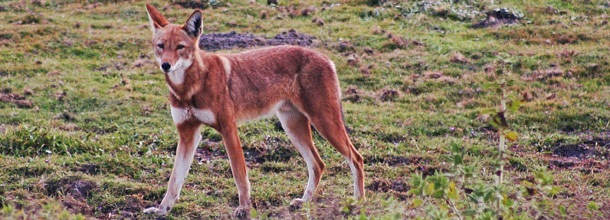You may remember a recent post recounting a trip that Will and I made to Ethiopia’s Bale Mountains National Park – a haven for keen twitchers, fishing fans and those in search of the ultimate off-the-beaten-track experience.
If not, a brief reminder: Bale falls within the Afromontane ecosystem. Although found throughout the continent, this habitat type is discontinuous, separated by geographical barriers of lowlands, meaning that the species found in the Bale that are specially adapted to the Afromontane conditions are restricted to this area. This has given Bale one of the highest incidences of endemic species of both flora and fauna across Africa and possibly the world. This includes one of the rarest canids – the Ethiopian wolf.
Not unlike its better-known arctic counterpart, the grey wolf, the Ethiopian wolf lives in social structures of up to 20 individuals. However, where we can draw certain parallels between the two, there are also things that make them different. For example, grey wolves hunt in packs due to the availability of large prey. On the contrary, in hunting terms, Ethiopian wolves are solitary, highly specialised to hunt Afromontane rodents, having adapted to hunting this readily available prey as recently as 100,000 years ago, since their movement from Eurasia into Africa. Convergent evolution – adaptations that cause two species from different lineages to have similar traits – has therefore caused a skull shape not dissimilar to jackals. The Ethiopian wolf is also extremely rare and, with an estimated 500 in the wild (half of which are over a year old), they easily make endangered status on the IUCN Red List.
The snag, with regards to its ever decreasing numbers, is this: the human population of Ethiopia is now over 100 million and counting. As the outskirts of villages encroach ever more onto the habitat of the wolf, it faces two serious problems: degradation of habitat through over-grazing of livestock, and the transmission of disease from domestic dog to wolf – namely rabies.
The Ethiopian Wolf Conservation Programme (EWCP) serves to protect the wolf through a number of well strategised goals. One of these is restoration of habitat, with the admission that the wolf serves as a flagship species representing all Afromontane animals at risk of encroachment. Raising awareness and support, after all, is of the utmost importance in any conservation programme. Another focus, which, as told by Claudio Sillero, director, caught them on the back foot this year, is disease prevention. Here’s what Sillero had to say in EWCP’s annual report:
“The dreaded rabies virus raised its ugly head again, and we found ourselves immersed in yet another emergency. EWCP intervened quickly to avoid widespread mortality among Ethiopian wolves in Bale. Some 120 wolves were vaccinated, representing roughly a quarter of the world’s population. As no packs went extinct, and subsequent breeding was good, the worst affected populations are already on the way to recovery.”

Aside from rabies, there are many other diseases that can spread between the dog and wolf population. Education and awareness campaigns have been integral to vaccination programmes for the dogs of local people that may have previously been reluctant.
Bale is somewhere very close to our hearts. Its landscapes matching that of wild Scotland – just with more warthog, antelope, endemic birdlife and, yes, wolf – is enough to strike a resounding chord in the heart of anyone visiting. I certainly recommend it. If, however the work of EWCP and others like it give you a desire to go beyond simply travelling to Africa, to rather creating a longer term relationship with some of the charities, NGOs, initiatives and programmes, then please to have a look at our Wild Philanthropy site. It’s exactly what we do. Help save threatened wildernesses and the endangered animals they hold.
